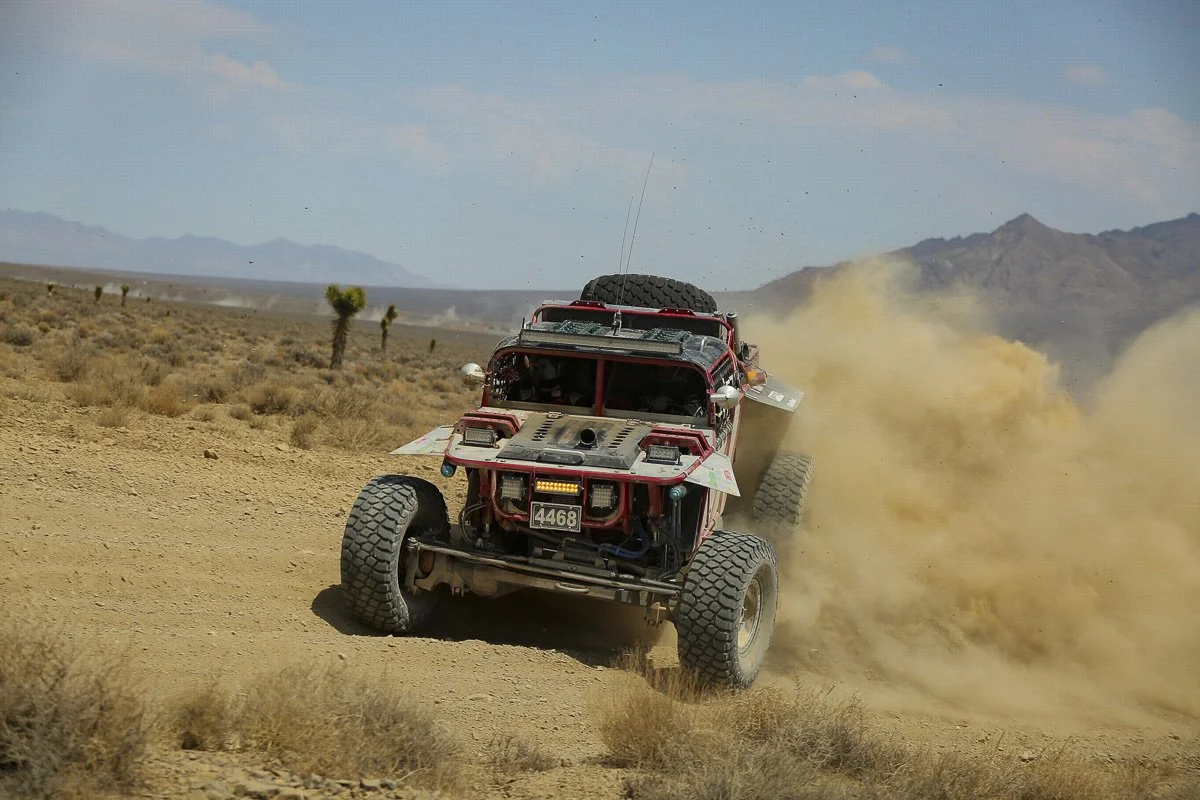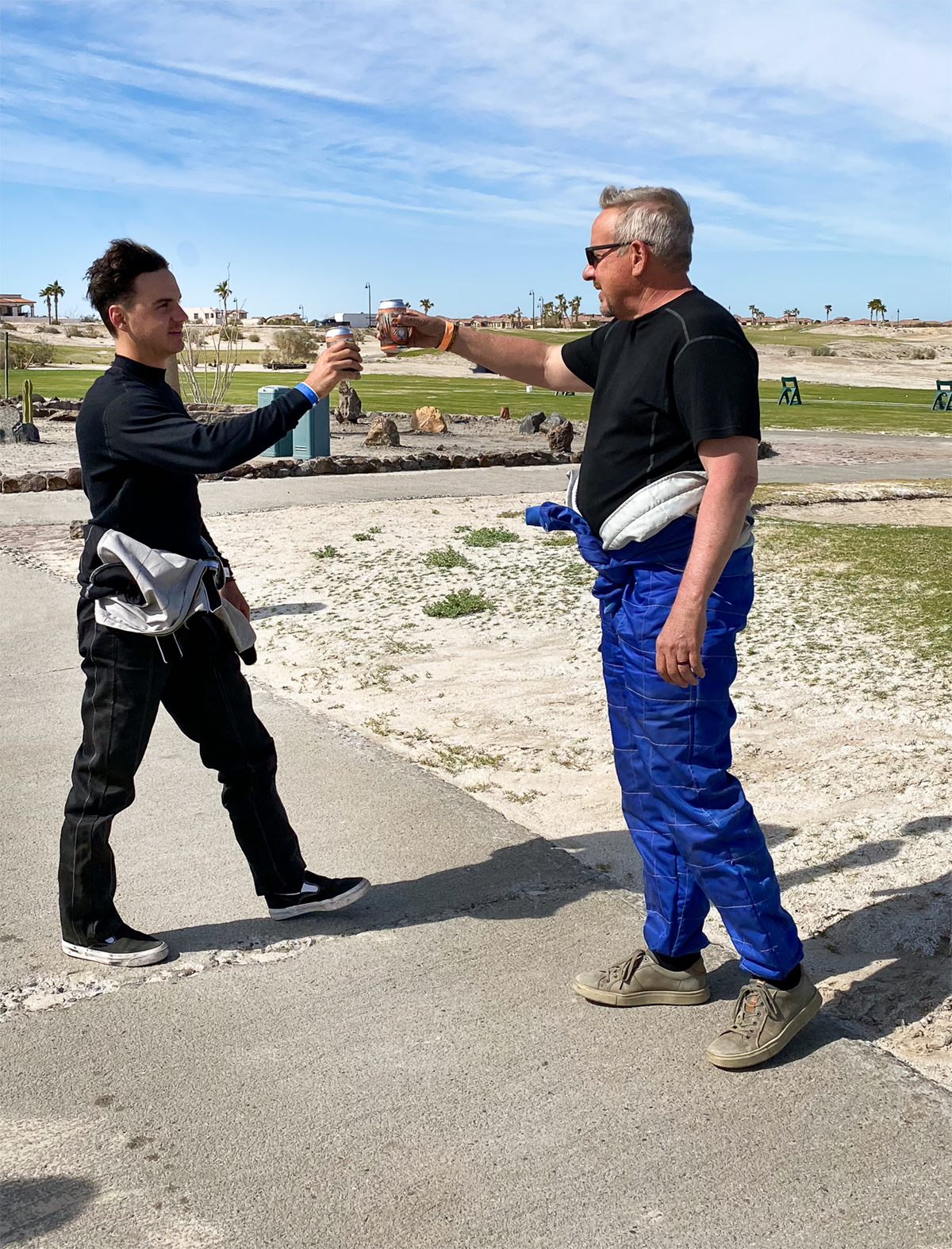Vegas to Reno Desert Race
Daniel Life
November 3, 2021
Reporting from Bonnie Claire, NV
60 miles from Las Vegas
This story is for race fans, and is an excerpt from our full case study found here.
Off-road racer Goliath with Swarm-based Sierra Turbines SATCOM solution mounted on the roof.
August 13, 4:53 AM - Paul Zaro rolls the race vehicle out of a car trailer. It's wheels are water jet cut steel disks that look like barbell weights, and make loading and unloading possible. They glide in a special channel mounted to the the back of the combination door/ramp.
"I don't sleep well the night before a race. I have crazy dreams about the mechanical items. It's too exciting. I'm wound up and want to get started." The race day mechanical checklist from last night get's a second run through.
The race vehicle is Goliath, a 4-wheeled, 750 horsepower, custom creation by Paul. Running on 112 octane race fuel, it's not a car or a truck. It's an elegant monster, funded out of pocket by Paul. He's the team's primary mechanic.
Goliath Stats
5:31 AM - With his full attention on Goliath, Paul doesn't notice Dave Zicovich, walk over. "You too excited to sleep again, Paul?" Zicovich is a driver for the team. That's when he's not building custom homes for Silicon Valley executives.
Together they are Paul Zaro/Zicovich Racing. Driver/navigator Jack Zicovich, is a real estate investment analyst, and Dave's son. Driver/navigator and electric bike entrepreneur, Andrew Davidge rounds out the team. Paul’s day job provides the carbon offset for 112 octane racing fuel . He fabricates and installs data center cooling systems that use water (absorption chillers) instead of traditional refrigerants, which helps to reduce energy consumption in Data centers..
The full crew shows up and together they install the wide knobby racing tires. Bonnie Claire Nevada is this year's starting point for the 550 mile Vegas to Reno race through the desert.
The race is held primarily in areas under the control of the Bureau of Land Management. Yesterday was Tech Inspection, and Goliath checked out with flying colors.
Race Stats
10:30 AM - It's go time!
Two days of racing through the desert.
At 10:30 its already 93º, UV Index of 6, and only a 2 mph wind to blow the dust around. By 3:30 the humidity will drop to 14% and the temp will 106º. Waiting for the green light, the team sits in full racing suits, helmets, and full Nomex fireproof underwear. A fabric helmet skirt and head scarves are there to catch the sweat and keep some of the dust out. Pumps push fresh air into the helmets and a small water tube offers occasional sips between adrenaline peaks.
Racers are being started with an extra time gap as there isn't enough wind to clear the fine silt dust from the start area. Radio safety checks complete, Dave and Andrew get the signal. Dave hits the accelerator trying not to rock spray the start line officials.
Goliath jumps forward with traction at all 4 wheels.
Wait, that's a half-wave antenna on Goliath!
Half-wave antenna mounted on Goliath
David Zicovich recalls, "Roger Smith texted me one time while I was at a race. I sent him back a picture of Goliath and the desert. He called me and said he had an idea. He asked me if we would put a box and an antenna on Goliath and track it with satellites. Roger also said he wanted to put sensors on Goliath and send messages to and from the vehicle. I asked what it was for."
Roger replied, "It's part of our command and control system. It's better than commercial avionics systems because it's two-way communications vs. one."
Zicovich said, "if you're looking to test something, there's no harsher environment than off-road racing other than battle. He immediately thought that was a pretty darn good idea."
‘Flight deck’ inside Goliath. Analog gauges are preferred over digital.
Much of the technology in off-road racing is analog because it can take the abuse. Digital tech is starting to appear more at races, but the preference is for old-school gauges.
For the race, the Sierra team opted for a half-wave antenna. It is approximately 1 meter long vs. the sub-1 foot quarter-wave antenna which was secured on top of the roof. A Swarm Eval kit 01 including the Swarm Tile satellite data modem was also on the roof. A Swarm data plan and a custom application developed by team Sierra provided a two-way, always-on connection.
Read more about Swarm and the development of Sierra Turbines’ enterprise application here.
Image at Left shows quarter-wave antenna used for early testing. Right: half-wave antenna and Swarm Eval kit.
Below: What Goliath was transmitting to and receiving from while zipping across the desert.
Image Courtesy of Swarm: https://www.swarm.space
Testing the Prototype on Interstate 5
Quarter wave through the sun roof
Before going to the desert, the Sierra Turbines development team decided to do a Northern California to Southern California pilot. Roger was not ready to permanently mount an antenna to his SUV. Instead, they secured the 1' long antenna inside the vehicle and let it poke out through the open sunroof. Roger drove to Los Angeles while Russ tracked the vehicle.
Russ: "When Roger was driving down I-5, I was tracking and watching the data. In the process, we got a temperature warning. The message was that the modems' temp was over 30º Celsius (86º F). The modem was directly in the sun. We knew the modem would still work fine at that temperature, we simply inserted a number to ensure we received a warning message. As another test, we reported every time the temperature went up by five degrees Celsius. This would trigger a warning message. We only ever got one, so it never got above 35º Celsius (95º F). It all performed well."
Results
To date, Sierra Turbines has completed about 2000 kilometers of enterprise level testing. A combination of road tests on freeways, city streets, and remote areas have served as test locations. The team did a big push with testing in rural California and Nevada before going to the desert. A large portion of the testing included areas outside cellular coverage. Including Smith Valley, Nevada
Smith Valley, Nevada - 122.5 square miles. Population 1,627. Elevation 4,790 feet.
Roger:
"It's really a testament – this is an enterprise application. It's got to work where there's no cell coverage."
When cell coverage is available in the desert, it’s natural to get curious about what’s nearby.
Tracking mobile assets at 100 miles per hour
August 13th, 12:58 PM - Pit Stop 1 of the Vegas to Reno Race.
Andrew Davidge and Jack Zicovich have been racing for about 2 and a half hours. The sun is hot. The silt dust hangs in the air from the vehicles ahead. Boulders, smaller rocks, scrub brush, and 70+ year-old saguaro cactus test the duos' ability to go fast and avoid obstacles. Because they are in race mode, only the biggest of problems command their attention.
Jack Zicovich: "We made it to Pit 1, and found a few issues with the car. They were OK to drive on. After we left Pit 1, our Lowrance system froze. It wasn't tracking us. It's not a newer model. Andrew hit reset. I was trying to help him get back to the right screen, and driving without a map. We came up on a corner at 75 or 80 mph, but I had no idea it was a 90º turn.
We start to pivot into the turn and I prepare to counter steer. At precisely the wrong moment, all 4 wheels line up. They catch the dirt and the vehicle just flips over. You don't really spin around on a corner like a go kart or car on tarmac. We weren't going to finish the race."












After Jack and Andrew were picked up by the track safety team and back within cell coverage, David Zicovich phoned his wife. He led with, "Our son Jack is OK, but there was an accident."
Jack Zicovich: "Andrew made a good observation that we'd probably be more sore to have run the whole race. You're just getting your ass kicked out there because it's so brutal. The road is so rough. There were a few times where I was under-braking, and going into a corner, the steering wheel would get ripped out of my hands. It was 3 hours of hard work."
When Goliath tumbled over, the Swarm equipment on top took a beating. The antenna was mostly fine, and the development kit box had gotten loose. It was cracked, and parts had moved around inside. Data collection stopped, with the last message 6 minutes before the rollover. It included Jack and Andrew's GPS coordinates.
Russ Winsper:
"We were following Goliath and getting data back and forth throughout the race. When they stopped at Pit 1, we could tell. When the car stopped running, we knew right where it was. We just didn't have cell coverage to call and find out how they were."
Roger Smith:
"At that point, we didn't care about the testing. We had to find out if Jack and Andrew were OK. We had to wait, and the 40 minutes seemed like a very long time."
While the race was in progress, Goliath sent email messages to the remote team.
In talking to Roger and Russ about the results, it was clear they see testing as a regular part of the process. When asked if they’d do it off-road in the future, Roger smiled and quickly answered, “NORRA Mexican 1000. But first we have to get Goliath some additional sponsorship.”






























